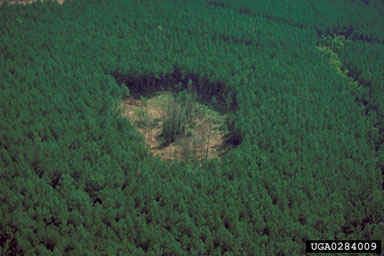|
Shortleaf pine, Pinus echinata, is one of the
four most important commercial softwoods in the southern United States. It
has the widest geographical range of any of the southern yellow pines covering
the landscape from New York to Florida, the Atlantic Coast to west Texas.
It is second only to loblolly pine in standing timber volume in these
areas. A major contributor to this fact is shortleaf's ability to adapt to
a great variety of site and soil conditions. Found on drier ridge sites
where there is less competing vegetation, the species will
grow best on deep well-drained soils.
Wet sites need to be avoided in order to prevent littleleaf disease, a serious
pathological threat to the species.
Shortleaf pine seedlings are shade intolerant and
will generally do poor on sites with high levels of competition. When
compared to loblolly seedlings and hardwood regeneration, the shortleaf pine
grows much slower and takes much longer to dominate a site. Long term
rotations must be considered to gain the full economic return on an investment
in shortleaf pine. Control of site competition, both woody and non-woody
plants, will result in increased economic gains for the landowner.

Several species of wildlife will
utilize shortleaf stands. White-tailed deer will often be found browsing
on the succulent needles of young seedlings. Songbirds, dove, and quail
will seek shelter in shortleaf stands due to the resilience the species shows
during wind, ice, and storm events. Older individuals with red heart rot
are the choice nesting grounds of the Red-cockaded woodpecker, an endangered
species.
Shortleaf pine was initially planted
as an erosion control measure. However, that use is declining because of
the popularity of faster growing loblolly pine and that shortleaf pine
does not create as much of a litter layer as other species. Shortleaf
pine is more ice resistant than loblolly pine and is preferred in ice-prone
areas. Shortleaf
pine is now primarily used for lumber, plywood, and other structural
materials. It can be used as pulpwood as well. Many log-home builders and owners prefer shortleaf logs to
other pine species for its dense wood, aesthetic, and sound structural qualities.
|